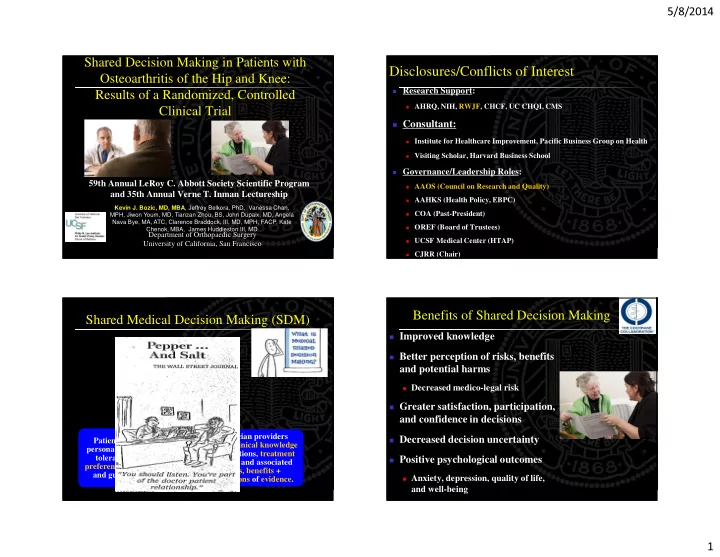

5/8/2014 Shared Decision Making in Patients with Disclosures/Conflicts of Interest Osteoarthritis of the Hip and Knee: Results of a Randomized, Controlled � Research Support: Clinical Trial � AHRQ, NIH, RWJF, CHCF, UC CHQI, CMS � Consultant: � Institute for Healthcare Improvement, Pacific Business Group on Health � Visiting Scholar, Harvard Business School � Governance/Leadership Roles: 59th Annual LeRoy C. Abbott Society Scientific Program � AAOS (Council on Research and Quality) and 35th Annual Verne T. Inman Lectureship � AAHKS (Health Policy, EBPC) Kevin J. Bozic, MD, MBA , Jeffrey Belkora, PhD, Vanessa Chan, MPH, Jiwon Youm, MD, Tianzan Zhou, BS, John Dupaix, MD, Angela � COA (Past-President) Nava Bye, MA, ATC, Clarence Braddock, III, MD, MPH, FACP, Kate � OREF (Board of Trustees) Chenok, MBA, James Huddleston III, MD Department of Orthopaedic Surgery University of California, San Francisco � UCSF Medical Center (HTAP) � CJRR (Chair) Benefits of Shared Decision Making Shared Medical Decision Making (SDM) � Improved knowledge In SDM process both In SDM process both � Better perception of risks, benefits physician and patient physician and patient make necessary make necessary and potential harms contributions to the contributions to the dialogue. dialogue. � Decreased medico-legal risk � Greater satisfaction, participation, and confidence in decisions Physician providers Physician providers � Decreased decision uncertainty Patient contributes Patient contributes expert clinical knowledge expert clinical knowledge personal input of their personal input of their of conditions, treatment of conditions, treatment tolerance for risk, tolerance for risk, � Positive psychological outcomes options and associated options and associated preferences for lifestyle, preferences for lifestyle, risks, benefits + risks, benefits + and guiding values. and guiding values. � Anxiety, depression, quality of life, limitations of evidence. limitations of evidence. and well-being 1
5/8/2014 Challenges to Implementing SDM in Orthopaedics � Limited training, familiarity with SDM � Observational study examining association between decision aids � Issues with evidence for hip and knee OA and rates of TJR and costs within Group � Gaps in evidence, CER on risks, benefits, alternatives Health � Difficult to consolidate, synthesize � Decision aids associated with 26 percent fewer hip replacement surgeries, 38 percent fewer knee replacements, and 12– � Cultural norms among patients, physicians 21 percent lower costs over six months. � Caveat: � Logistics, costs, efficiency � Surgery rates HIGHER among patients with ‘prevalent OA’ who were � Incentives? considered ‘better candidates for surgery’! � Conclusion: SDM steers marginal surgical candidates away from � Fee for service payment system surgery, appropriate surgical candidates towards surgery Methods � Purpose � 120 patients with hip/knee OA � To evaluate the impact of � 2 Academic Institutions (UCSF and Stanford) decision and communication � Randomized aids on patient knowledge, � SDM Intervention or Usual Care efficiency of decision making, treatment choice, and patient and provider satisfaction in patients with advanced OA of the hip and knee. 7 8 2
5/8/2014 Measurements/Outcomes Results: Primary Outcome � Primary outcome � Patients who arrived an at informed decision after � Patients reached an informed decision after 1 st visit their first office consultation � Patients Control Group Intervention � Knowledge (N=60) Group (N=60) 40 (66.7%) 25 (41.7%) � Stage in Decision Making No informed decision � Treatment Choice 20 (33.3%) 35 (58.3%) Informed � Satisfaction decision � Surgeon P<0.01 � Appropriate of patient questions � Satisfaction Secondary Outcome: Patient Confidence Secondary Outcome: Stage in Decision Making How far along are you with this decision? � Confidence in knowing what questions to ask their doctor Outcome Measures Control Intervention Total p-value (N=62) (N=61) (N=123) Have already chose an option 10 (16.1%) 15 (25.0%) 25 (20.5%) 0.06 Outcome Measures Control Intervention p-value Close to choosing an option 12 (19.4%) 16 (26.7%) 28 (23.0%) (N=62) (N=61) Pre-Consultation Considering the different options 24 (38.7%) 24 (40.0%) 48 (39.3%) “I know what questions 6.7 + 2.4 7.9 + 2.1 0.0034 to ask my doctor” Not yet thought about all the 16 (25.8%) 5 (8.3%) 21 (17.2%) options 3
5/8/2014 Secondary Outcome: Surgeon Satisfaction Secondary Outcome: Choice of Treatment Outcome Measures Control Intervention p-value (N=62) (N=61) How appropriate was the content of 4.9 + 1.8 7.2 + 1.7 <0.0001 the patient’s questions? How satisfied were you with the 5.5 + 2.3 7.7 + 1.9 <0.0001 efficiency of the consultation? Outcome Measures Control Intervention Total p-value (N=62) (N=61) (N=123) What was your overall satisfaction of 5.1 + 2.0 7.7 + 1.8 <0.0001 this consultation? “Which treatment do you 0.48 want to do to treat your hip or knee osteoarthritis?” Non-operative treatment 19 (30.6%) 22 (36.7%) 41 (33%) Surgery 43 (69.4%) 38 (63.3%) 81 (66.4%) Results: Duration of Office Visit � Next Steps � Articulate a common value proposition of SDM that resonates with patients, surgeons, payors/purchasers Outcome Measures Control Intervention p-value � Develop/evaluate business (N=62) (N=61) models Time of entire patient visit 51.0 + 21.1 53.5 + 23.8 0.38 � Identify, overcome Time spent with surgeon 21.0 + 7.2 20.9 + 6.8 0.91 barriers to adoption 4
5/8/2014 Conclusions � SDM tools can be used to incorporate medical knowledge, patient preferences/values into medical decision making Thank � Benefits to patients, providers You!!! � Enhance knowledge, decision quality/confidence � Improve efficiency of consultation � Identify appropriate candidates for surgery � Important in facilitating adoption of SDM tools into routine orthopaedic practice � Important policy implications in value-based care 5
Recommend
More recommend